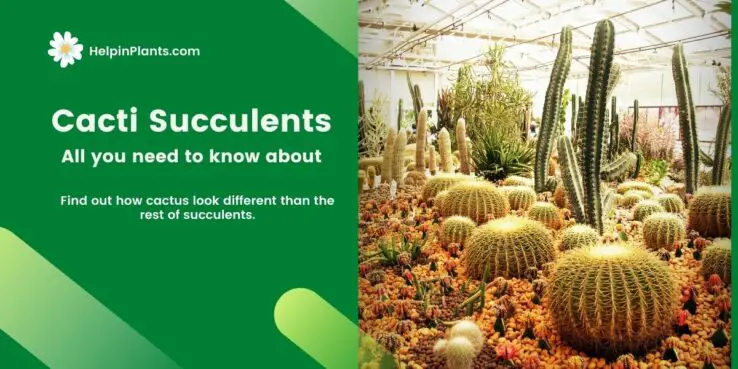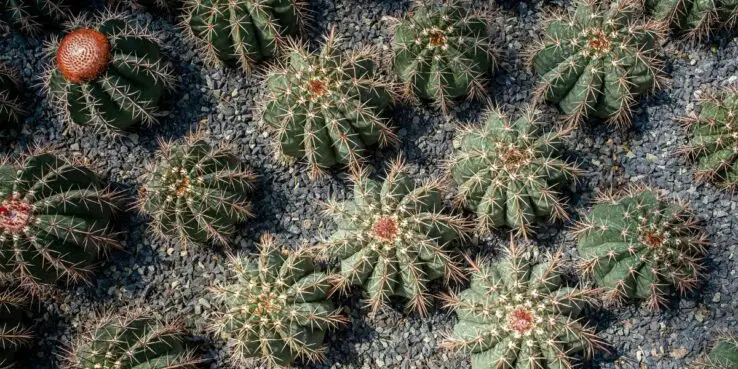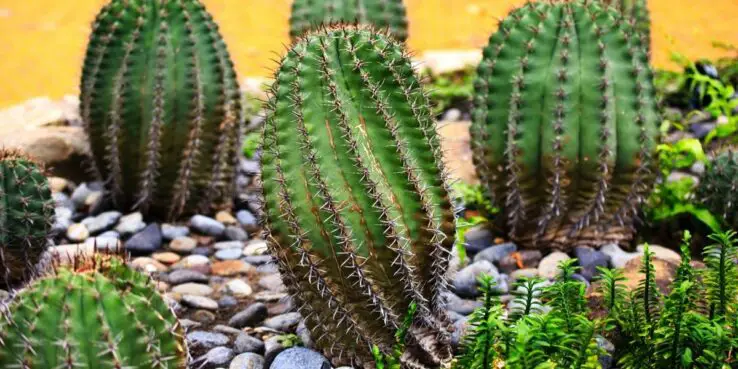
Cacti Succulents - All you need to know about
Cacti are part of succulents and they differ a little bit from other succulent plant families. They both need to be watered more than once a week, they both require the same light conditions, and they both grow best when planted with other cacti or other succulent plants near them for support.
It is also worth mentioning that, All cacti are succulents, but not all succulents are cacti.
What are cacti / cactus plants?

Cactus is a member of the plant family "Cactaceae" in Succulents. They have scales and spines instead of leaves and can be found in many different shapes, sizes, colors, textures - even smells! Cactus plants are also called "cactuses" or "cactus trees."
Most cacti are originated from hot, dry habitats with sparse rainfall. Cacti is the only plant variety that can survive such conditions and they have evolved to adapt. Over many years they have developed some significant physical adaptations to survive.
Cacti are characterized by having special structures equipped with new forms, namely ridges on their body to store water. The cactus plant's thickened shape is to prevent loss of moisture, while its effectively located spines are used to protect it from animals.
Cactus plants usually have thick, fleshy stems to store water which they can bear for long periods of time.
The most common types of cactus plants are prickly pears (also known as nopales), barrel-shaped saguaros that tower up to 50 feet tall, and chollas that look like giant barrels covered in thorny spines.
Cacti and Succulents Info
A cactus is a member of the Cactaceae family, which includes nearly 127 genera and 1750 known species of Caryophyllales order. The word "cactus" (kak-tus) comes from Latin and means "spiny." Theophrastus used it to describe a spiny plant that is now uncertain.
Cacti are found in areas such as Central and South America, where they thrive in heat and dry habitats. Many other cactus, on the other hand, come from all across Canada and are even native to rainforests.
Cacti that live in the jungle area are usually known as epiphytes, just like bromeliads; because many of them actually get their water from the air.
Other cacti look like small barrel-shaped plants, and there are even types that come in a shade of purple.
Succulents are defined as "juicy" or fleshy plants by their name. Succulent plants have thick leaves or stems that are filled with fluids, nutrients, and water. These leaves enable the plant to grow in adverse environments all across the globe. Typically, these leaves have a glossy or leathery finish, and the texture protects them from moisture loss.
Cacti are considered succulents because they store water in the same manner as succulents. Some growths on cacti (called areoles), make them distinctive. These are technically compressed branches that are cushioned growing points. Spines, "wool" flowers, and offsets develop from the areoles.
Pereskia is the only genus of cactus consists of only about 4 species, look different than other types of cacti, and having many leaves. Even their stems look different than succulents.
Generally, cacti plants have globular or cylindrical bodies. Opuntias have round, segmented stems. Epiphyllums have strap-shaped stems. Many cacti have prominent spines, barbs, or bristles, and some even have woolly hair.
How to care for cactus succulents

Caring for cacti succulents is very easy and similar to growing succulents. They generally require the same care as each other.
Caring for cacti is very easy you just need to ensure that there is enough water and fertilizer, light, and some ventilation. You can help your plant grow faster by giving it a good potting mix for cactus and succulent plants.
If you want to propagate your cactus plant all you have to do is remove a branch or a side shoot and place it into the soil, then cover with some soil and mist the area where the cutting has been placed. Hopefully, in a few weeks, you'll get a new cactus plant.
Here are the basic requirements for growing cacti succulents.
Its Soil should be well-draining and nutrients rich
Starting from the soil, it should be well-draining and nutrient-rich. It should be porous enough to retain moisture but well-drained to avoid standing water.
Most cactus species have shallow root systems and need a light potting mix with an ideal balance of water and air porosity.
Want to know more about succulents soil, check these resources
Water your cactus sparingly
A good rule of thumb is that only water your cactus, when the soil is completely dry, or at least the top inches of the soil dries. Usually, it is once every 7-14 days depending on your environment.
Caring for cacti requires ensuring that they receive enough water to avoid dehydration but not so much as to cause root rot.
Succulents will need more frequent watering than other plants in the same pot, especially during the summer when their growth is very rapid. While in the dormant season, you can reduce watering.
Learn more about how often to water succulents.
Give it enough bright light/sunlight
In their native habitats, most cacti plants receive almost all-day sun. So in your area, you will need to provide them with similar types of light conditions to make them thrive.
The type of lighting you provide for these plants will depend on the species and their growing environment.
Be careful not to expose succulents and cacti to the full sun immediately after they have recovered from being indoors. It can cause sunburn that may result in deformities or even death.
Keep your desert cacti in hot temperature
Cactus plants should be kept in a location that is between 20°C and 30°C (68°F - 86°F) during the day with at least 12 hours of sunlight.
Cacti thrive in a wide range of temperatures, which varies depending on the species and the time of year. When cacti are in their active growth stage, they require temperatures ranging from 68°F to 86+°F.
In the winter, when they're dormant, they prefer colder temperatures, with an average low of 45°F. Cacti that are tolerant to cold can survive in frost as well.
Also, place them near an east-facing sunny window where they will receive plenty of light without too much heat buildup. The hot sun can burn their thin stems or leaves, while the full direct sun may cause deformities or other problems if they have mostly grown indoors.
Fertilize in its growing season
Fertilizing them in the spring and summer will help them grow strong vegetative bodies that are less susceptible to pests and diseases, which usually attack plants weakened by lack of nutrients.
Cacti are pretty responsive to fertilizers. You can fertilize your cactus plant once it has started growing after winter.
You can use a general-purpose fertilizer for cactus and succulents, feeding it once every month or two during the growing season.
Provide sufficient humidity
The ideal range of humidity varies by species, but generally, 50%-80% is a good place to start. Where possible, you should put the pot on a saucer of rocks and fill it with water so that the plant can draw water from the substrate as it needs it.
Humidity is essential to ensure your plant does not dehydrate.
If this is not possible, then misting or setting your container in a tray filled with pebbles and water is an alternative.
Transplant and Prune if needed
Cacti or succulents are mostly slow-growing, but they may outgrow a pot with time and they need to be transplanted into new bigger containers when these plants become root-bound or their growth slow down than normal.
For example, when you begin to see the white part of the stem (crown) at the soil line in spring, it is time for transplanting.
When transplanting succulents into new containers, be careful not to tear roots along the crevice between fleshy leaves.
Prune any dead or damaged parts of the plants before re-planting them in new pots. You can also prune your cacti to control its growth and/or propagate new cactuses.
Pests and Diseases of Cacti plants
While bacterial and fungal infections caused by overwatering are the most typical problems with cactus and succulents cultivated as houseplants, they do get occasional insect infestations. Scale, mealy bugs, and root mealybugs are the most prevalent pests. Spider mites and fungus gnats are less common insects to be concerned about.
The difference between cacti and succulents
Botanically cacti are succulents, but physically, there are some differences between cacti and other succulent plants.
- Cacti feature areoles with spines, thorns, or bristles, while most succulents do not have any special features.
- Cacti have rounder bodies, while succulents tend to be more oblong in shape.
- Generally, cacti have no leaves/foliage or very few.
- Cacti are native to America and Mexico, while succulents can be found on all over the world except Antarctica.
- Cacti are the most drought resistant plants on earth. They can withstand extremely arid conditions for months at a time without any rainfall or additional watering.
Different types of cacti and succulent plants
There are thousands of types of succulents and cacti. Some of them are toxic like the jade plant, some are good for hanging baskets (like "String of pearls" Senecio rowleyanus), while some other plants are edible and have health benefits (e.g. Aloe vera). Even some succulent types are considered cacti but in fact, they are not.
Some popular succulents which are mistaken as cacti include:
- Aloe Vera (Aloe barbadens)
- Euphorbia (Euphorbia obesa, E. milii and others)
- Huernia
- Agave (Agave americana)
- Ice plants, or Aizoaceae
- Haworthia (Haworthia cooperi and others)
- Pachypodium
- Stapeliads
- Gasteria
- Lithops
- Panda Plant (Kalanchoe tomentosa)
Some cacti are edible, but many are toxic. If you want to consume cacti make sure you know which cacti are edible and not poisonous.
Some popular types of cacti include:
- Ferocactus Barrel Cactus (Ferocactus wislizenii)
- Crown cactus (Rebutia)
- Opuntia Prickly Pear Cactus (Opuntia ficus-indica or O. stricta)
- Ball cactus (Parodia)
- Cereus Peruvian Apple Cactus (Cereus peruvianus)
- Uebelmannia cactus (Uebelmannia)
Tips on planting cacti in the right place in your home or garden
- The best light conditions for indoor cacti is bright, indirect sunlight. If you cannot provide the full sun, the plant will do well with bright, filtered light.
- All desert cacti should be planted in a well-drained soil. The best mix includes two parts potting soil to one part coarse sand.
- Make sure you use a container with drainage holes. If water stays in the soil in your pots instead of draining through, it will drown your cacti and cause root rot or ugly brown spots on their leaves.
- Desert Cacti can be planted in outdoor gardens when night-time temperatures are above 55F (13 C).
- To overwinter cacti in the garden, reduce watering in early autumn when they are transitioning to their winter dormant state.
- Desert Cacti and forest cacti for indoors should be watered about every two weeks during the growing season (spring and summer). Water less frequently in fall and winter, when they are in their resting stage.
- Cactus succulents can easily survive periods of drought, so it is best to be a little bit on the underwater side instead.
- Cacti, especially, Desert Cacti do not need very much fertilizer. Feed them once or twice during the growing season only, using an all-purpose houseplant food diluted to half strength.
- Do not fertilize in fall and winter because it could encourage growth at a time when your cacti need to be dormant.
- Generally, forest cacti have trailing nature having large flowers. So they're ideal for hanging baskets display.
- Desert cacti are beautiful and delicate, with a distinctive, elegant beauty. Some of the desert cactus bloom with the most exquisite blooms in the plant kingdom.
- Larger plants look best in pots of their own.
- You can propagate a wide variety of cacti and succulents by just cuttings.
- If you provide your cacti conditions like their natural environment, they will flourish in it. Some will also bloom with pink, Blue, Purple, Brown & Green, or white flowers. (flower color and time varies on its type)
Conclusion
Cacti are a family of plants or a sub-category of plants in Succulents plants. They need excellent care to flourish. Cactus plant tend to be more drought-resistant than other plant life, so they can withstand extremely arid conditions for months at a time without any rainfall or additional watering.
Succulent plants require regular watering in order to stay healthy because many succulents store water in their leaves or roots rather than having true stems.
More importantly, cacti have spines while most succulents do not. Therefore you can easily pick the one that is best suited for your home's landscaping after knowing the difference.
FAQs about Cacti & Succulents
Are succulents the same as cactus?
Basically, the cactus is a sub-category of succulents.
How do you take care of cactus and succulents?
Simply provide them what they need, i.e. Use well-draining soil, water regularly but let the soil completely dry, place them in bright light or where it gets indirect sun, fertilize during spring and summer, replant if they become bigger than their containers, and reduce watering & fertilizer during winter dormant season.
Do cactus succulents need sunlight?
Yes, most cacti need indirect sunlight, or a bright light if grown indoors. They thrive in a bright light source. It is best to keep them in the east-facing window, so the hotter sun rays won't damage your plant foliage.
How much sunlight do cactus succulents need?
Succulents and cacti require 10 to 14 hours of sunlight a day, on average.
Are succulents and cacti the same?
No, succulents are fat-stemmed plants while cacti are fleshier with long spines on the body. Cacti are a sub-category (family) of Succulents.
How do you care and grow cactus succulents?
First of all, it needs well-draining soil, bright location but indirect sunlight. Water moderately, fertilize during spring and summer only, propagate if bigger than its container. Reduce watering and fertilizing during the winter dormant phase.
Are cactus succulents good for home?
They are great for low-maintenance indoor plants. It is good to be put in the east-facing window so they get the maximum amount of sunlight. They can survive through the winter by reducing watering and fertilizing.
What is the difference between a cactus and a succulent?
A cactus is a family or sub-category in a bigger category, called, Succulents. Generally, cactus succulents have long spines while succulents do not. Both need optimal conditions to thrive, i.e. good draining soil, bright location but indirect sunlight, water moderately, reduce watering and fertilizing during the winter dormant phase.
Cactus succulents are succulents that have spines. Succulent plants are not cacti even though they look like them. They only have left to help them retain moisture and store water. The easiest way to tell the difference is by looking at the leaves. Cacti have spines and round bodies while most succulents don't.
How often should you water cacti and succulents?
Watering frequency depends on the type of container, location, and time of year. Generally speaking, winter dormant plants require less watering than summer active ones.
Water your indoor plants once every one to two weeks during the winter.
